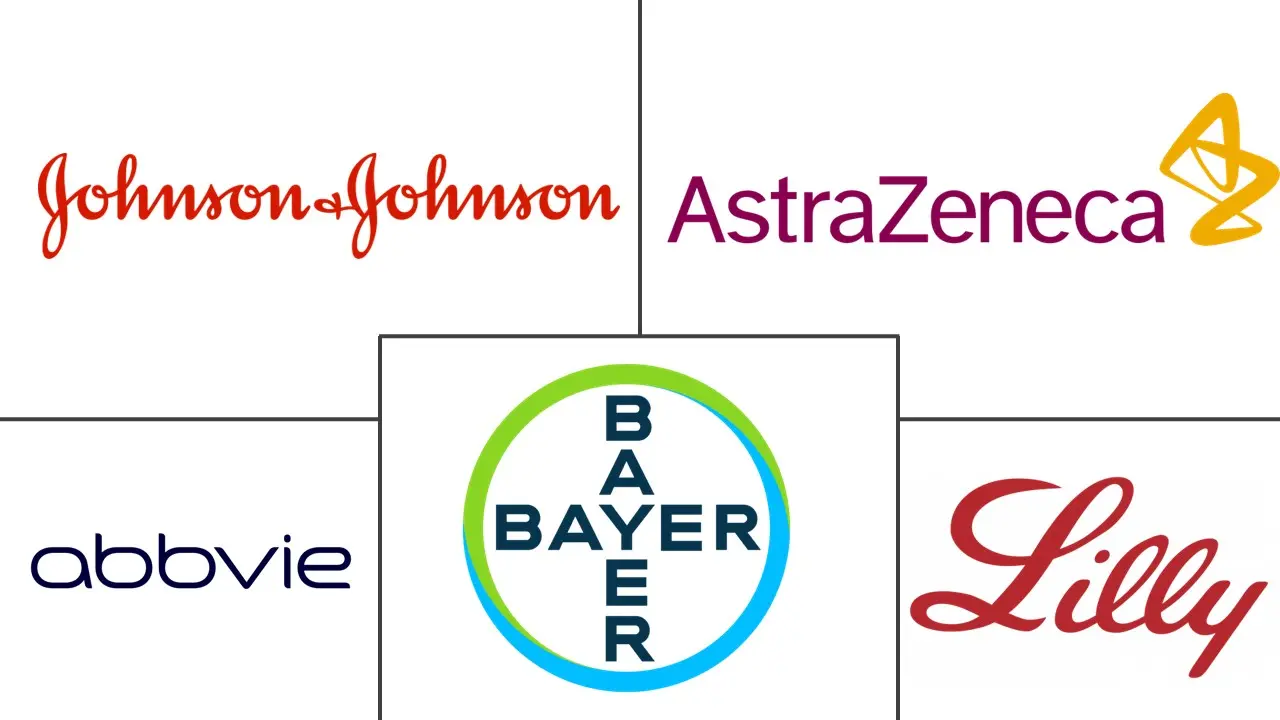Diabetic Nephropathy Market Size and Share
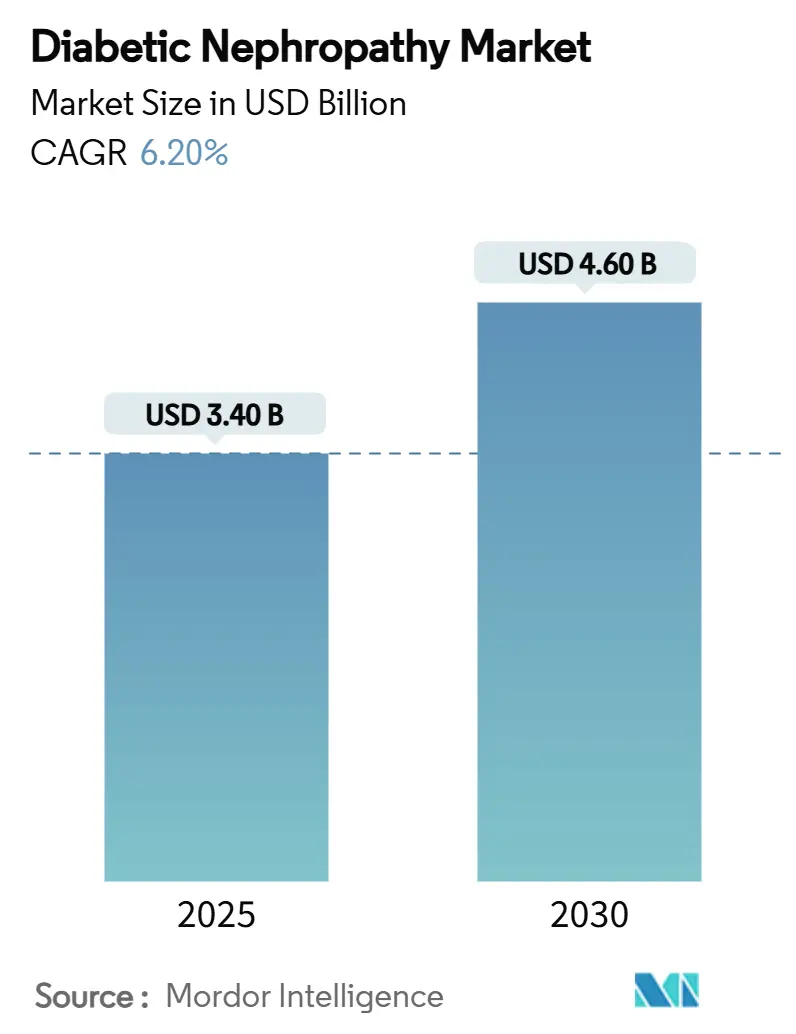
Diabetic Nephropathy Market Analysis by Mordor Intelligence
The diabetic nephropathy market size stood at USD 3.4 billion in 2025 and is projected to reach USD 4.6 billion by 2030, reflecting a 6.2% CAGR over the forecast period. Heightened clinical urgency, driven by the fact that diabetic kidney disease affects 40% of people living with diabetes, underpins the expansion of the diabetic nephropathy market. Shifts toward combination therapy, exemplified by dual finerenone-empagliflozin regimens, are redefining treatment standards. Regulatory momentum, showcased by the FDA’s accelerated approvals for novel mechanisms, is shortening the innovation cycle. Adoption of sodium-glucose cotransporter-2 (SGLT2) inhibitors, coupled with value-based care incentives, is broadening patient access. Regionally, Asia-Pacific delivers the sharpest growth curve, while North America retains leadership through entrenched reimbursement structures and early technology uptake.
Key Report Takeaways
- By drug class, ACE inhibitors led with 33.1% of the diabetic nephropathy market share in 2024, whereas SGLT2 inhibitors are forecast to advance at a 12.5% CAGR to 2030.
- By diabetes type, type 2 diabetes accounted for 78.6% share of the diabetic nephropathy market size in 2024, while type 1 diabetes is poised for the fastest 9.6% CAGR through 2030.
- By distribution channel, hospital pharmacies dominated with 50.9% revenue share in 2024; online pharmacies are expected to climb at a 14.2% CAGR to 2030.
- By geography, North America captured 37.4% of the diabetic nephropathy market size in 2024; Asia-Pacific is forecast to record a 9.3% CAGR between 2025 and 2030.
Global Diabetic Nephropathy Market Trends and Insights
Drivers Impact Analysis
| Driver | (~) % Impact on CAGR Forecast | Geographic Relevance | Impact Timeline |
|---|---|---|---|
| Rising Diabetes Prevalence & Ageing Population | +1.80% | Global, with highest impact in Asia Pacific and Middle East | Long term (≥ 4 years) |
| Clinical Adoption Of SGLT2 Inhibitors Post-CREDENCE & EMPA-REG Trials | +1.50% | North America & Europe leading, expanding to Asia Pacific | Medium term (2-4 years) |
| Guideline Shift Towards Early RAS-Blockade Intensification | +0.90% | Global, with faster adoption in developed markets | Medium term (2-4 years) |
| AI-Based Urinary Biomarker Panels Enabling Pre-Emptive Therapy | +0.70% | North America & Europe initially, scaling globally | Long term (≥ 4 years) |
| Value-Based Kidney-Care Payment Bundles In Developed Countries | +0.60% | North America primarily, with EU pilot programs | Short term (≤ 2 years) |
| Emergence Of Combination Therapy Strategies | +0.80% | Global, with early adoption in developed markets | Medium term (2-4 years) |
| Source: Mordor Intelligence | |||
Rising Diabetes Prevalence & Ageing Population
Escalating diabetes prevalence, particularly the 68% surge in type 2 diabetes projected for Asia by 2045, is enlarging the addressable base for the diabetic nephropathy market.[1]R. Hamid, “Projected 68% Rise in Type 2 Diabetes Prevalence Across Asia by 2045,” Journal of Diabetology, jdiabetol.com Genetic susceptibility at lower body-mass indices accelerates kidney complications, prompting earlier screening programs reliant on biomarkers such as NGAL and KIM-1. Ageing adds further strain, as natural declines in renal function hasten the transition from microalbuminuria to overt nephropathy. Health systems are rolling out population-wide screening alongside prevention campaigns. These intertwined demographic pressures are expected to sustain long-run growth for the diabetic nephropathy market.
Clinical Adoption of SGLT2 Inhibitors Post-CREDENCE & EMPA-REG Trials
Landmark trials such as CREDENCE and EMPA-REG demonstrated renal and cardiovascular protection independent of glucose control, driving guideline upgrades that elevate SGLT2 inhibitors to first-line status. Real-world evidence indicates a 45% lower in-hospital mortality for continuous SGLT2 inhibitor users during admissions.[2]Claire Jackson, “Continued SGLT2 Inhibitor Use Cuts In-Hospital Mortality in Diabetes by 45%,” Diabetes Care, care.diabetesjournals.org The recent U.S. approval of sotagliflozin for heart failure in chronic kidney disease broadens applicability. Adoption gaps persist, with only a minority of eligible patients prescribed these agents, leaving headroom for the diabetic nephropathy market to expand. Growing payer recognition of total-cost-of-care savings is expected to accelerate uptake.
Guideline Shift Toward Early RAS-Blockade Intensification
The Asian Pacific Society of Nephrology now recommends immediate initiation of ACE inhibitors or ARBs in hypertensive diabetic patients. This shift from glucose-centric management to proteinuria suppression underscores the evolving evidence base. Combination strategies are proliferating, marrying ACE inhibitors with SGLT2 inhibitors and mineralocorticoid receptor antagonists (MRAs) such as finerenone to target fibrosis pathways.[3]Y. Chen, “Epidemiology of Diabetic Kidney Disease in China,” Frontiers in Endocrinology, frontiersin.org Clinical data suggest that triple therapy may approach a ceiling of incremental benefit, nudging research toward endothelin receptor antagonists and complement inhibitors. Standardized RAS-focused pathways reinforce consistent prescribing and underpin predictable expansion of the diabetic nephropathy market.
AI-Based Urinary Biomarker Panels Enabling Pre-Emptive Therapy
Machine-learning algorithms combining genomics, proteomics, and metabolomics are surpassing creatinine-based methods in predicting chronic kidney disease trajectories. Integration with telehealth permits continuous outpatient monitoring and algorithm-triggered alerts. Emerging urinary panels—transferrin, type IV collagen, and α1-microglobulin—detect tubular injury before overt albuminuria, offering a longer therapeutic runway. Earlier identification aligns with precision dosing and reduces progression risk, strengthening value-based narratives for payers. Scalable AI diagnostics will thus reinforce demand across the diabetic nephropathy market.
Restraints Impact Table
| Restraint | (~) % Impact on CAGR Forecast | Geographic Relevance | Impact Timeline |
|---|---|---|---|
| High List-Price Of Novel Agents (E.G., Finerenone) | -1.20% | Global, with highest impact in price-sensitive markets | Short term (≤ 2 years) |
| Stringent Renal-Safety Regulatory Endpoints Prolonging Approvals | -0.80% | Global regulatory markets, particularly US and EU | Medium term (2-4 years) |
| Low Nephropathy Awareness In Low- & Mid-Income Countries | -0.60% | Sub-Saharan Africa, South Asia, Latin America | Long term (≥ 4 years) |
| Venture Capital Shift Toward Multi-Organ Metabolic Drugs | -0.40% | North America and Europe primarily, affecting R&D funding | Medium term (2-4 years) |
| Source: Mordor Intelligence | |||
High List-Price of Novel Agents (e.g., Finerenone)
At roughly USD 19 daily, finerenone stretches affordability thresholds, particularly under budget-capped health systems. Insurers impose step-therapy protocols, lengthening the path to optimal care and dampening the velocity of uptake. Lifelong therapy magnifies cumulative expenditure versus acute indications. U.S. price negotiations under Medicare starting in 2026 will heavily discount older diabetes drugs, yet novel agents stay outside those bargains, maintaining cost pressure when combination regimens pair multiple premium agents, affordability barriers compound, muting near-term growth for the diabetic nephropathy market.
Stringent Renal-Safety Regulatory Endpoints Prolonging Approvals
Post-nephrotoxicity vigilance has prompted regulators to insist on hard outcomes such as sustained eGFR decline, necessitating longer, larger trials. Atrasentan’s accelerated approval, contingent on confirmatory studies beyond proteinuria reduction, exemplifies the hurdle. Trial designs must accommodate heterogeneous progression rates and cardiovascular comorbidities, inflating R&D costs. Recent failures like monlunabant underscore the difficulty in hitting stringent composite endpoints within diverse populations. Protracted timelines slow the entry of innovative classes, tempering the diabetic nephropathy market’s growth.
Segment Analysis
By Drug Class: SGLT2 Inhibitors Reshape Treatment Paradigms
ACE inhibitors retained the largest 33.1% diabetic nephropathy market share in 2024. SGLT2 inhibitors, however, headline growth with a 12.5% CAGR through 2030, buoyed by approvals that now extend to non-diabetic chronic kidney disease and heart failure cohorts. ARBs provide first-line alternatives when ACE inhibitors are contraindicated. MRAs such as finerenone address residual inflammation and fibrosis, gaining traction for proteinuric patients resistant to RAS blockade. Diuretics retain a role in fluid management, while GLP-1 receptor agonists and DPP-4 inhibitors occupy an emerging “Others” niche owing to ancillary renal effects.
Clinical data from the CONFIDENCE trial showed that dual finerenone-empagliflozin therapy outperforms monotherapy, foreshadowing a pivot from single-drug dominance to regimen-based care. Furthermore, the diabetic nephropathy market size for combination-oriented approaches is expected to escalate as endothelin receptor antagonists and complement inhibitors, such as atrasentan and iptacopan, secure accelerated approvals. Growing clinician familiarity with multidrug protocols is reinforcing formulary placement and supporting adoption curves.
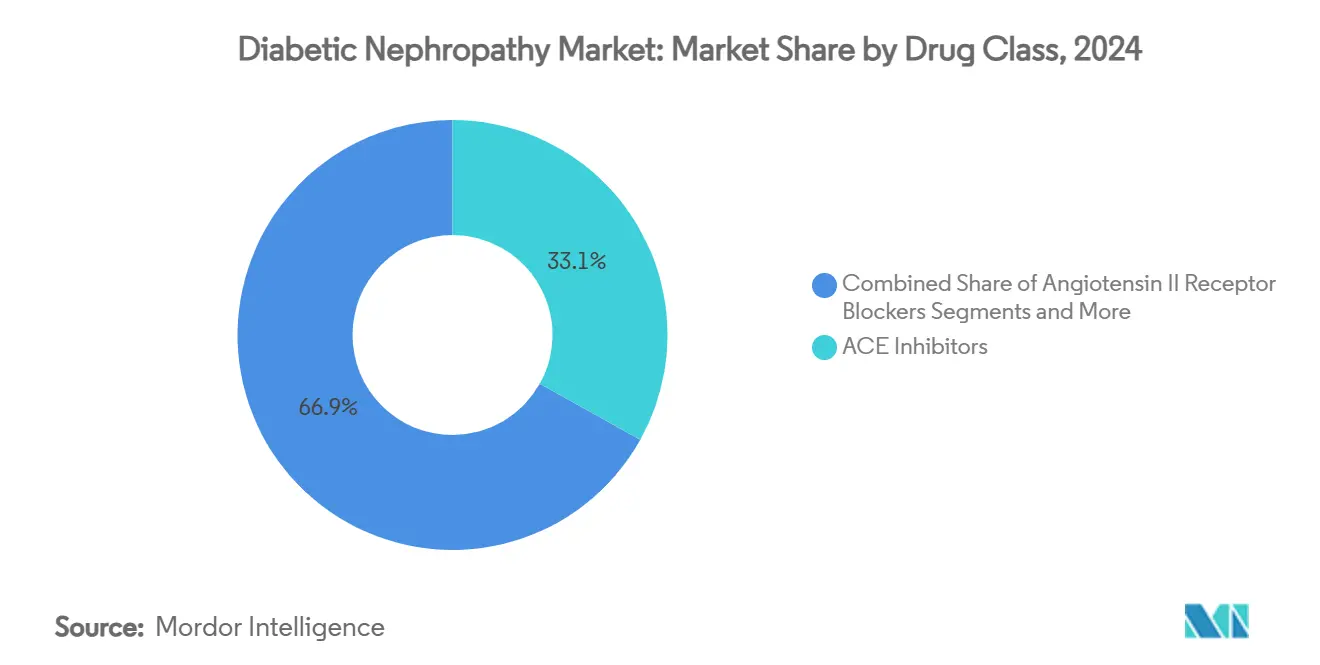
Note: Segment shares of all individual segments available upon report purchase
By Diabetes Type: Type 1 Precision Medicine Drives Growth
Type 2 diabetes contributed 78.6% to the diabetic nephropathy market size in 2024, mirroring its global epidemiological weight. Extensive protocols incorporating ACE inhibitors, SGLT2 inhibitors, and MRAs underpin predictable revenue flows in this large cohort. Precision medicine initiatives, however, are spotlighting type 1 diabetes nephropathy, which, although smaller in volume, is expected to expand at a 9.6% CAGR through 2030.
The National Institute of Diabetes and Digestive and Kidney Diseases allocated USD 1.3 million to refine type 1-specific therapeutic targets under the Kidney Precision Medicine Project. Younger onset and longer disease duration create distinctive inflammatory pathways, calling for bespoke regimens. Early evidence suggests that off-label finerenone confers proteinuric benefit in type 1 cases, adding momentum. Collectively, specialized protocols and dedicated funding channels are amplifying the diabetic nephropathy market’s growth within the type 1 segment.
By Distribution Channel: Digital Health Accelerates Online Growth
Hospital pharmacies commanded 50.9% of the diabetic nephropathy market share in 2024, reflecting the complexity of dose titration, laboratory monitoring, and comorbidity management. Retail pharmacies furnish accessible refills for stable patients but face limitations with high-cost therapies needing close follow-up. Online pharmacies are projected to grow at 14.2% CAGR by 2030, propelled by telemedicine integration that bundles prescription delivery with remote patient monitoring.
Smartphone-based platforms capture blood pressure, glucose, and symptom data, feeding dashboards reviewed by clinicians who make timely therapy adjustments. AI-driven adherence reminders demonstrably reduce hospitalization risk, reinforcing the online channel’s appeal to payers seeking value-based outcomes. Despite temperature-sensitive biologics requiring cold-chain logistics, technology-enabled traceability is improving reliability. These advances are positioning online distribution as a pivotal conduit within the diabetic nephropathy market.

Note: Segment shares of all individual segments available upon report purchase
Geography Analysis
North America dominated with 37.4% share of the diabetic nephropathy market in 2024, underpinned by mature insurance frameworks, extensive clinical trial networks, and rapid adoption of first-in-class therapies. Medicare’s Kidney Care Choices Model incentivizes early-stage management, boosting prescription volumes. Upcoming 68% Part D discounts on legacy diabetes drugs will redirect savings toward novel nephroprotective agents, further fortifying demand.
Asia-Pacific represents the fastest-growing region, projected at a 9.3% CAGR through 2030. Prevalence of microalbuminuria (39.8%) and macroalbuminuria (18.8%) among Asian type 2 diabetes patients underscores the public-health emergency. Governments are funding early screening, while expanding insurance pools open doors for high-value therapies.
Europe maintains solid volume through universal healthcare and structured health-technology assessments. EMA approvals of finerenone and atrasentan illustrate regulators’ balanced stance on innovation and safety. Meanwhile, the Middle East, Africa, and South America exhibit emerging potential amid rising diabetes incidence and incremental reimbursement reforms, although price sensitivity may temper near-term uptake. Together, regional dynamics shape a diversified demand profile for the diabetic nephropathy market.
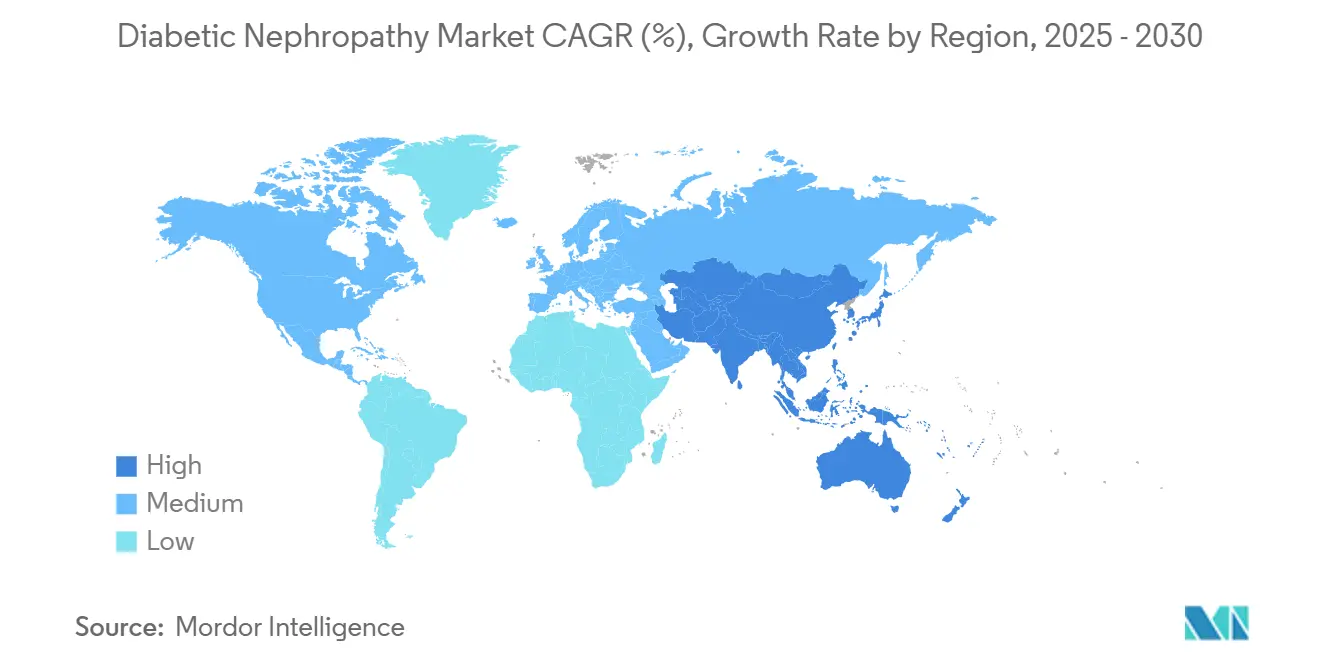
Competitive Landscape
The diabetic nephropathy market is moderately consolidated, with global majors leveraging multi-mechanism portfolios. AstraZeneca drives dapagliflozin adoption across renal and heart-failure settings, while Bayer positions finerenone as a cornerstone anti-fibrotic therapy. The Boehringer Ingelheim–Eli Lilly alliance sustains empagliflozin’s momentum through joint marketing. Pipeline activity is brisk, spotlighted by AstraZeneca’s Phase III baxdrostat-dapagliflozin study targeting resistant hypertension in chronic kidney disease.
M&A remains a strategic lever: Biogen’s USD 1.15 billion purchase of Human Immunology Biosciences secured felzartamab, an anti-CD38 monoclonal antibody with Breakthrough Therapy status for kidney indications. Accelerated FDA approvals for endothelin receptor antagonists and complement inhibitors, such as atrasentan and iptacopan, have opened revenue avenues for firms like Novartis. Competitive differentiation is increasingly tied to digital health add-ons and AI diagnostics that bolster real-world outcomes for payer negotiations.
White-space innovations target precision medicine for type 1 diabetes nephropathy, digital adherence tools, and novel inflammation pathways. Strategic collaborations, as seen in the Lilly-Boehringer model, facilitate shared R&D costs and combined sales forces. Collectively, these maneuvers reinforce the growth trajectory of the diabetic nephropathy market while intensifying rivalry among incumbents and newcomers.
Diabetic Nephropathy Industry Leaders
-
AstraZeneca plc
-
Bayer AG
-
Eli Lilly and Company
-
Johnson & Johnson
-
AbbVie Inc.
- *Disclaimer: Major Players sorted in no particular order
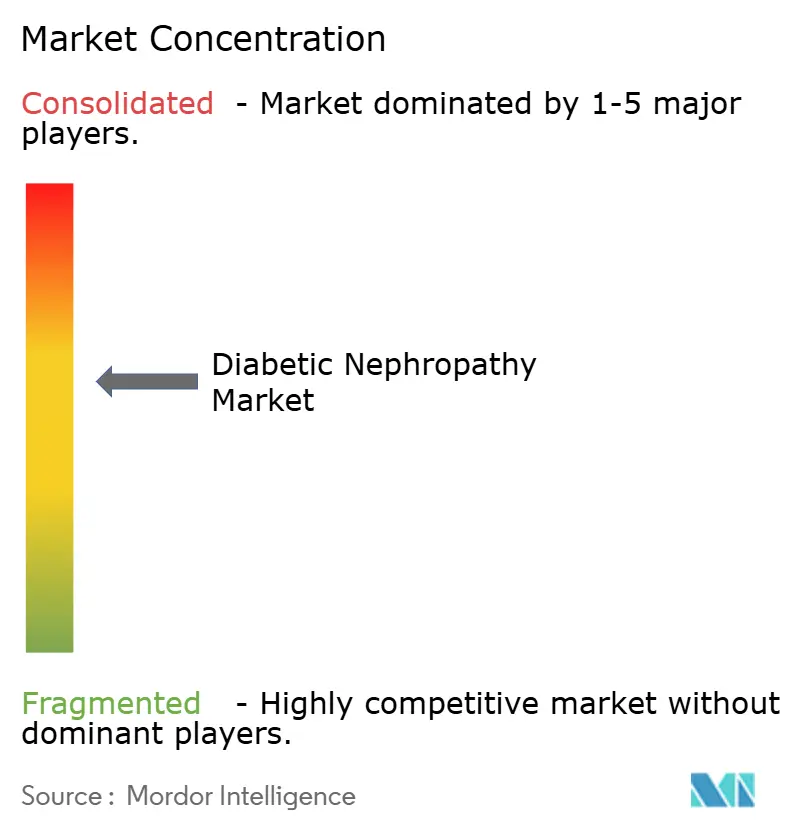
Recent Industry Developments
- June 2025: The New England Journal of Medicine published CONFIDENCE trial data showing superior renal outcomes with finerenone plus empagliflozin versus monotherapy.
- May 2025: Biogen agreed to acquire Human Immunology Biosciences for USD 1.15 billion, adding felzartamab to its renal pipeline.
- April 2025: The FDA granted accelerated approval to Vanrafia (atrasentan) for proteinuria reduction in primary IgA nephropathy.
- April 2024: Novartis received FDA accelerated approval for Fabhalta (iptacopan) targeting proteinuria in IgA nephropathy.
Global Diabetic Nephropathy Market Report Scope
| ACE Inhibitors |
| Angiotensin II Receptor Blockers (ARBs) |
| SGLT2 Inhibitors |
| Mineralocorticoid Receptor Antagonists (MRAs) |
| Diuretics |
| Others (GLP-1 RAs, DPP-4, etc.) |
| Type-1 Diabetes |
| Type-2 Diabetes |
| Hospital Pharmacies |
| Retail/Community Pharmacies |
| Online Pharmacies |
| North America | United States |
| Canada | |
| Mexico | |
| Europe | Germany |
| United Kingdom | |
| France | |
| Italy | |
| Spain | |
| Rest of Europe | |
| Asia Pacific | China |
| Japan | |
| India | |
| South Korea | |
| Australia | |
| Rest of Asia Pacific | |
| Middle East & Africa | GCC |
| South Africa | |
| Rest of Middle East & Africa | |
| South America | Brazil |
| Argentina | |
| Rest of South America |
| By Drug Class | ACE Inhibitors | |
| Angiotensin II Receptor Blockers (ARBs) | ||
| SGLT2 Inhibitors | ||
| Mineralocorticoid Receptor Antagonists (MRAs) | ||
| Diuretics | ||
| Others (GLP-1 RAs, DPP-4, etc.) | ||
| By Diabetes Type | Type-1 Diabetes | |
| Type-2 Diabetes | ||
| By Distribution Channel | Hospital Pharmacies | |
| Retail/Community Pharmacies | ||
| Online Pharmacies | ||
| By Geography | North America | United States |
| Canada | ||
| Mexico | ||
| Europe | Germany | |
| United Kingdom | ||
| France | ||
| Italy | ||
| Spain | ||
| Rest of Europe | ||
| Asia Pacific | China | |
| Japan | ||
| India | ||
| South Korea | ||
| Australia | ||
| Rest of Asia Pacific | ||
| Middle East & Africa | GCC | |
| South Africa | ||
| Rest of Middle East & Africa | ||
| South America | Brazil | |
| Argentina | ||
| Rest of South America | ||
Key Questions Answered in the Report
What is the current size of the diabetic nephropathy market?
The diabetic nephropathy market size is USD 3.4 billion in 2025 and is forecast to reach USD 4.6 billion by 2030.
Which drug class is expanding the fastest in diabetic kidney disease therapy?
SGLT2 inhibitors are the fastest-growing class, advancing at a 12.5% CAGR through 2030.
Why is Asia-Pacific considered the most dynamic regional market?
Rising diabetes prevalence, earlier onset of kidney complications at lower BMI levels, and improving insurance coverage drive a 9.3% CAGR in Asia-Pacific.
How do combination therapies influence clinical outcomes?
Dual therapy with finerenone and empagliflozin delivers superior renal outcomes compared with monotherapy, signaling a shift toward multi-drug regimens.
What limits immediate uptake of novel agents like finerenone?
A daily cost of roughly USD 19 and payer step-therapy rules create near-term access barriers, especially in price-sensitive markets.
How are digital health platforms changing medication distribution?
Online pharmacies linked to remote-monitoring apps are growing at a 14.2% CAGR, improving adherence and reducing hospitalizations for chronic kidney disease patients.
Page last updated on:
